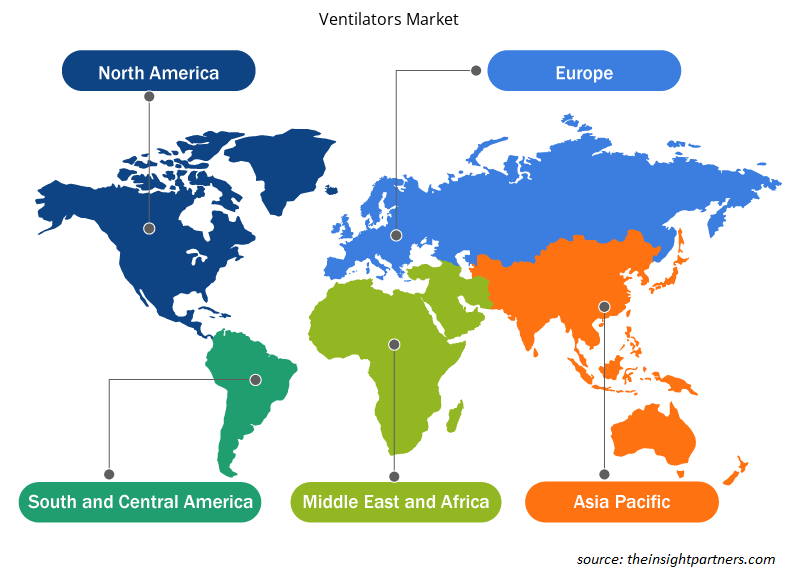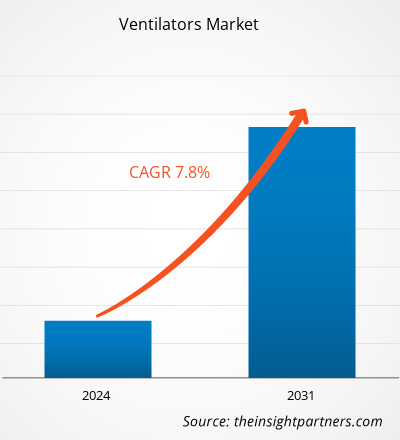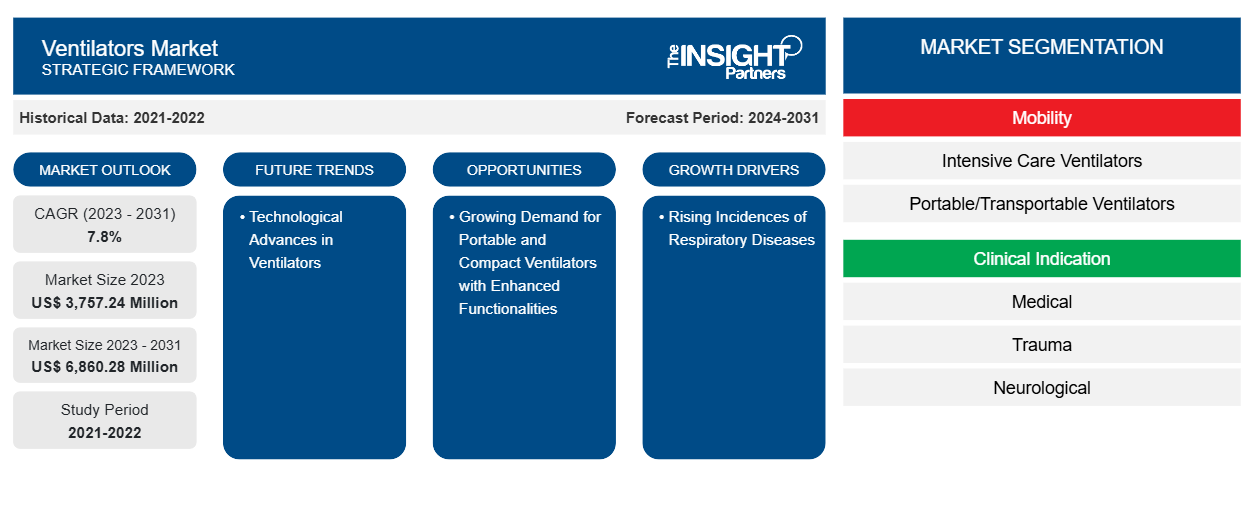Si prevede che il mercato dei ventilatori raggiungerà i 6.860,28 milioni di dollari entro il 2031, rispetto ai 3.757,24 milioni di dollari del 2023. Si prevede che il mercato registrerà un CAGR del 7,8% nel periodo 2023-2031. La crescente domanda di ventilatori portatili e compatti con funzionalità avanzate sarà probabilmente una delle tendenze chiave del mercato.
Analisi del mercato dei ventilatori
I fattori che guidano la crescita del mercato dei ventilatori sono i crescenti casi di broncopneumopatia cronica ostruttiva (BPCO), le emergenze respiratorie e i progressi tecnologici nei dispositivi per la cura respiratoria. L'avvento di dimensioni portatili, convenienti e adatte ai pazienti stimola ulteriormente l'uso dei ventilatori, determinando così una crescita del mercato. Inoltre, si prevede che le iniziative di sostegno governative volte a offrire un'assistenza sanitaria sicura, conveniente e di qualità aumenteranno la domanda di ventilatori durante il periodo di previsione. Vari attori del mercato dei ventilatori forniscono ventilatori, il che probabilmente stimolerà la crescita del mercato dei ventilatori. Hamilton Medical offre ventilatori denominati HAMILTON-C1 e Hamilton-C1 neo, un ventilatore neonatale che combina una gamma di opzioni terapeutiche con la mobilità in un ventilatore progettato esplicitamente per i neonati.
Panoramica del mercato dei ventilatori
Il mercato è alimentato da un aumento di individui anziani che sono suscettibili a disturbi respiratori, crescenti progressi nelle infrastrutture sanitarie e una maggiore adozione di tecnologie avanzate. Le persone anziane sono più inclini a gravi malattie causate da infezioni respiratorie rispetto alle persone più giovani a causa di problemi legati all'età, come la fragilità, che aumenta il numero di ricoveri ospedalieri e decessi. L'aumento della popolazione anziana ha causato un aumento delle malattie geriatriche, portando a un'enorme richiesta di terapia intensiva, che include la ventilazione meccanica. Secondo il database 2020 dei Centers for Disease Control and Prevention (CDC), il numero di pazienti e decessi per BPCO è molto maggiore tra le fasce di età più anziane, contribuendo all'86% dei decessi per BPCO tra queste fasce di età. L'invecchiamento è il fattore principale che contribuisce all'aumento dei casi di malattie cronico-degenerative. In alcuni casi, porta alla necessità di interventi che richiedono il ricovero in terapia intensiva. Pertanto, la rapida crescita della popolazione geriatrica incoraggia la domanda di supporto ventilatorio, che alimenta la crescita del mercato dei ventilatori.
Personalizza questo report in base alle tue esigenze
Riceverai la personalizzazione gratuita di qualsiasi report, comprese parti di questo report, o analisi a livello nazionale, pacchetto dati Excel, oltre a usufruire di grandi offerte e sconti per start-up e università
-
Scopri le principali tendenze di mercato in questo rapporto.Questo campione GRATUITO includerà analisi di dati che spaziano dalle tendenze di mercato alle stime e alle previsioni.
Driver e opportunità del mercato dei ventilatori
Aumento dell'incidenza delle malattie respiratorie per favorire la crescita del mercato
BPCO, asma, infezioni acute delle basse vie respiratorie, tubercolosi, cancro ai polmoni e altre malattie respiratorie sono tra le cause più comuni di gravi malattie e morte in tutto il mondo. Secondo i dati del 2023 dell'American Lung Association, circa 34 milioni di americani soffrono di malattie polmonari croniche come asma e BPCO. Secondo l'Office of Disease Prevention and Health Promotion, nel 2020, circa 14,8 milioni di adulti hanno ricevuto una diagnosi di BPCO negli Stati Uniti. Un ventilatore aiuta il paziente affetto da malattie respiratorie o altre condizioni simili a respirare. Pertanto, il trattamento delle malattie respiratorie richiede una ventilazione meccanica. Pertanto, il crescente carico di malattie respiratorie sostiene la domanda di ventilatori, stimolando così la crescita del mercato.
Progressi tecnologici nei ventilatori
La domanda di ventilatori innovativi, più piccoli, più silenziosi e più comodi che rispondano alle esigenze dei pazienti è in aumento, consentendo agli operatori sanitari di curare efficacemente i pazienti in terapia intensiva. Negli ultimi due decenni, i miglioramenti tecnici hanno notevolmente migliorato le prestazioni dei ventilatori per terapia intensiva. Con gli sviluppi nei ventilatori per terapia intensiva, sono prontamente disponibili modalità aggiuntive e l'interfaccia utente è stata modificata. La maggior parte della nuova generazione di ventilatori per terapia intensiva ha uno schermo di computer che controlla l'interfaccia utente, strategie di svezzamento automatizzate e sincronia del ventilatore. Inoltre, i ventilatori portatili sono un recente progresso tecnologico nei ventilatori. Si prevede che le dimensioni compatte del dispositivo trasformeranno l'assistenza ventilatoria offrendo portabilità, facilità d'uso, versatilità e una maggiore durata della batteria. È meno costoso di altri ventilatori per terapia intensiva e ha capacità sia invasive che non invasive. Di conseguenza, si prevede che il crescente settore dei ventilatori offrirà opportunità di crescita al mercato.
Analisi della segmentazione del rapporto di mercato dei ventilatori
I segmenti chiave che hanno contribuito alla derivazione dell'analisi di mercato dei ventilatori sono mobilità, indicazione clinica, interfaccia, pazienti, modalità e utente finale.
- In base alla mobilità, il mercato dei ventilatori è classificato in ventilatori per terapia intensiva e ventilatori portatili/trasportabili. Il segmento dei ventilatori per terapia intensiva ha detenuto la quota maggiore del mercato nel 2023. Si prevede che il segmento dei ventilatori portatili/trasportabili registrerà il CAGR più elevato durante il periodo di previsione.
- In termini di indicazione clinica, il mercato è categorizzato in medico, traumatologico, neurologico, chirurgico e altri. Il segmento medico ha detenuto la quota maggiore del mercato nel 2023. Si prevede che il segmento neurologico registrerà il CAGR più elevato durante il periodo di previsione.
- In base ai pazienti, il mercato dei ventilatori è diviso in adulti e pediatrici e neonatali. Il segmento degli adulti ha detenuto una quota di mercato maggiore nel 2023 e si prevede che registrerà un CAGR più elevato durante il periodo di previsione.paediatric & neonatal. The adult segment held a larger market share in 2023 and is anticipated to register a higher CAGR during the forecast period.
- In base all'interfaccia, il mercato dei ventilatori è diviso in invasivo e non invasivo. Il segmento invasivo ha detenuto una quota di mercato maggiore nel 2023. Si prevede che il segmento non invasivo registrerà un CAGR più elevato durante il periodo di previsione.CAGR during the forecast period.
- In termini di modalità, il mercato è segmentato in ventilazione in modalità combinata, ventilazione in modalità volume, ventilazione in modalità pressione, assistenza ventilatoria neuralmente regolata, ventilazione a rapporto inverso, ventilazione prona, ventilazione oscillatoria ad alta frequenza, ventilazione percussiva ad alta frequenza e altri. Il segmento della ventilazione in modalità combinata ha detenuto la quota maggiore del mercato nel 2023 e si prevede che registrerà il CAGR più rapido durante il periodo di previsione.CAGR during the forecast period.
- In base all'utente finale, il mercato è segmentato in ospedali e cliniche, assistenza domiciliare, centri di assistenza ambulatoriale e servizi medici di emergenza. Il segmento ospedali e cliniche ha detenuto la quota maggiore del mercato nel 2023 e si prevede che registrerà il CAGR più rapido durante il periodo di previsione.CAGR during the forecast period.
Analisi della quota di mercato dei ventilatori per area geografica
L'ambito geografico del rapporto sul mercato dei ventilatori è suddiviso principalmente in cinque regioni: Nord America, Asia Pacifico, Europa, Medio Oriente e Africa, Sud e Centro America.
Il Nord America ha dominato il mercato dei ventilatori. La crescita del mercato in questa regione è attribuita alla crescente attenzione degli operatori di mercato negli Stati Uniti e in Canada, all'elevata prevalenza di malattie respiratorie, all'aumento della popolazione geriatrica, all'elevata prevalenza del fumo, al sistema sanitario altamente sviluppato e alla crescente spesa sanitaria. Secondo i Bronchitis Facts and Statistics pubblicati a novembre 2022, la bronchite è una causa comune di ricovero ospedaliero degli adulti negli Stati Uniti. Circa 1 adulto statunitense su 20 soffre di bronchite acuta ogni anno e circa 10 milioni di persone (ovvero il 3% della popolazione) sono affette da bronchite cronica. Inoltre, la Canadian Nurse Association ha stimato che circa 3 milioni di canadesi soffrono di una delle gravi malattie respiratorie come asma, BPCO, cancro ai polmoni, fibrosi cistica, apnea notturna e malattie polmonari professionali. Inoltre, si prevede che l'Asia Pacifica crescerà con il CAGR più elevato nei prossimi anni.i.e., 3% of the population) are affected by chronic bronchitis. Moreover, the Canadian Nurse Association estimated that ~3 million Canadians suffer from one of serious respiratory diseases such as asthma, COPD, lung cancer, cystic fibrosis, sleep apnea, and occupational lung diseases. Further, Asia Pacific is anticipated to grow with the highest CAGR in the coming years.
Approfondimenti regionali sul mercato dei ventilatori
Le tendenze regionali e i fattori che influenzano il mercato dei ventilatori durante il periodo di previsione sono stati ampiamente spiegati dagli analisti di Insight Partners. Questa sezione discute anche i segmenti e la geografia del mercato dei ventilatori in Nord America, Europa, Asia Pacifico, Medio Oriente e Africa e America meridionale e centrale.

- Ottieni i dati specifici regionali per il mercato dei ventilatori
Ambito del rapporto di mercato sui ventilatori
| Attributo del report | Dettagli |
|---|---|
| Dimensioni del mercato nel 2023 | 3.757,24 milioni di dollari USA |
| Dimensioni del mercato entro il 2031 | 6.860,28 milioni di dollari USA |
| CAGR globale (2023-2031) | 7,8% |
| Dati storici | 2021-2022 |
| Periodo di previsione | 2024-2031 |
| Segmenti coperti |
Per Mobilità
|
| Regioni e Paesi coperti |
America del Nord
|
| Leader di mercato e profili aziendali chiave |
|
Densità degli attori del mercato dei ventilatori: comprendere il suo impatto sulle dinamiche aziendali
Il mercato dei ventilatori sta crescendo rapidamente, spinto dalla crescente domanda degli utenti finali dovuta a fattori quali l'evoluzione delle preferenze dei consumatori, i progressi tecnologici e una maggiore consapevolezza dei vantaggi del prodotto. Con l'aumento della domanda, le aziende stanno ampliando le loro offerte, innovando per soddisfare le esigenze dei consumatori e capitalizzando sulle tendenze emergenti, il che alimenta ulteriormente la crescita del mercato.
La densità degli operatori di mercato si riferisce alla distribuzione di aziende o società che operano in un particolare mercato o settore. Indica quanti concorrenti (operatori di mercato) sono presenti in un dato spazio di mercato in relazione alle sue dimensioni o al valore di mercato totale.
Le principali aziende che operano nel mercato dei ventilatori sono:
- Vyaire Medical Inc
- Azienda
- Società per azioni Dragerwerk AG & Co. KGaA
- Assistenza sanitaria Fisher e Paykel
- Assistenza sanitaria GE
- Hamilton Medico
Disclaimer : le aziende elencate sopra non sono classificate secondo un ordine particolare.

- Ottieni una panoramica dei principali attori del mercato dei ventilatori
Notizie di mercato e sviluppi recenti sui ventilatori
Il mercato dei ventilatori viene valutato raccogliendo dati qualitativi e quantitativi post-ricerca primaria e secondaria, che includono importanti pubblicazioni aziendali, dati associativi e database. Di seguito sono elencati alcuni degli sviluppi nel mercato dei ventilatori:
- Getinge ha lanciato il suo nuovo ventilatore meccanico Servo-c, mirato a mercati selezionati, offrendo strumenti terapeutici di protezione polmonare per il trattamento di pazienti sia pediatrici che adulti. Servo-c è destinato a rendere l'assistenza sanitaria accessibile e conveniente per più ospedali in tutto il mondo. (Fonte: Getinge, comunicato stampa, gennaio 2023)
- Max Ventilator ha lanciato ventilatori multifunzionali non invasivi (NIV), dotati di ossigenoterapia integrata e umidificatore. La nuova offerta dell'azienda è facile da usare, leggera e ha capacità multifunzionali uniche. Una caratteristica importante del dispositivo che lo fa risaltare in una configurazione di terapia intensiva è che c'è una disposizione specifica per collegare questo dispositivo a una "linea di evacuazione". (Fonte: Max Ventilator, comunicato stampa, maggio 2022)
Copertura e risultati del rapporto sul mercato dei ventilatori
Il rapporto "Dimensioni e previsioni del mercato dei ventilatori (2021-2031)" fornisce un'analisi dettagliata del mercato che copre le seguenti aree:
- Dimensioni e previsioni del mercato dei ventilatori a livello globale, regionale e nazionale per tutti i principali segmenti di mercato coperti dall'ambito
- Tendenze del mercato dei ventilatori, nonché dinamiche di mercato come driver, vincoli e opportunità chiave
- Analisi PEST e SWOT dettagliate
- Analisi di mercato dei ventilatori che copre le principali tendenze del mercato, il quadro globale e regionale, i principali attori, le normative e i recenti sviluppi del mercato
- Analisi del panorama industriale e della concorrenza che copre la concentrazione del mercato, l'analisi della mappa di calore, i principali attori e gli sviluppi recenti nel mercato dei ventilatori
- Profili aziendali dettagliati
- Analisi storica (2 anni), anno base, previsione (7 anni) con CAGR
- Analisi PEST e SWOT
- Valore/volume delle dimensioni del mercato - Globale, Regionale, Nazionale
- Industria e panorama competitivo
- Set di dati Excel
Report recenti
Testimonianze
Motivo dell'acquisto
- Processo decisionale informato
- Comprensione delle dinamiche di mercato
- Analisi competitiva
- Analisi dei clienti
- Previsioni di mercato
- Mitigazione del rischio
- Pianificazione strategica
- Giustificazione degli investimenti
- Identificazione dei mercati emergenti
- Miglioramento delle strategie di marketing
- Aumento dell'efficienza operativa
- Allineamento alle tendenze normative























 Ottieni un campione gratuito per - Mercato dei ventilatori
Ottieni un campione gratuito per - Mercato dei ventilatori